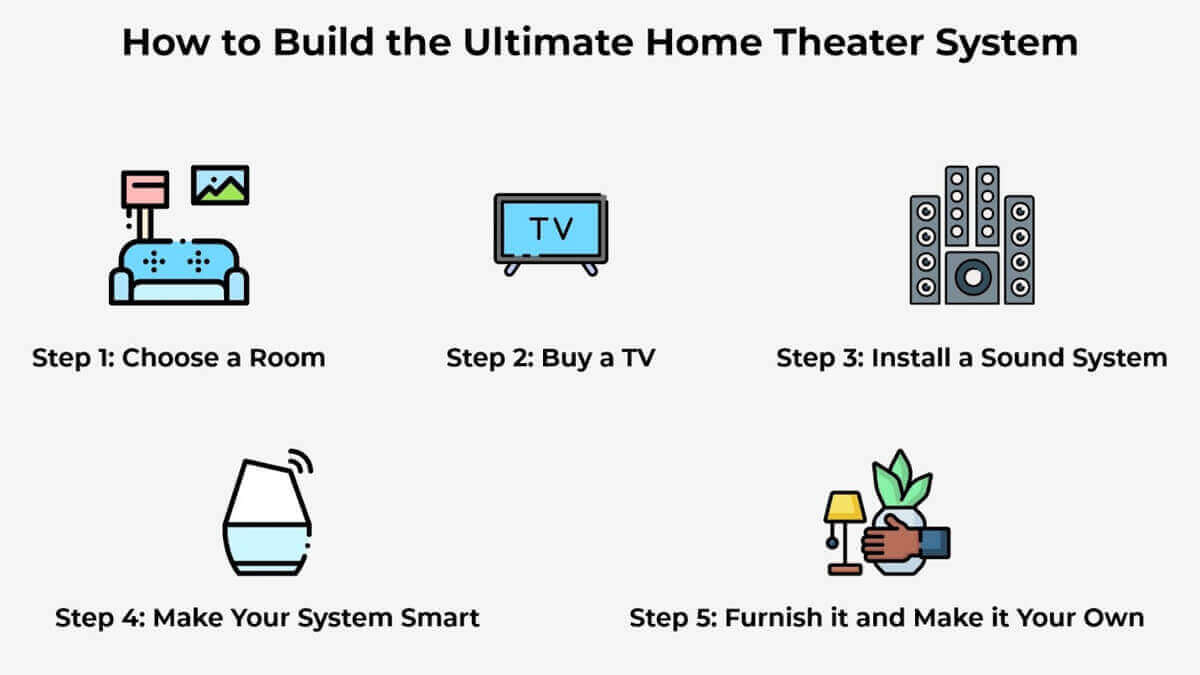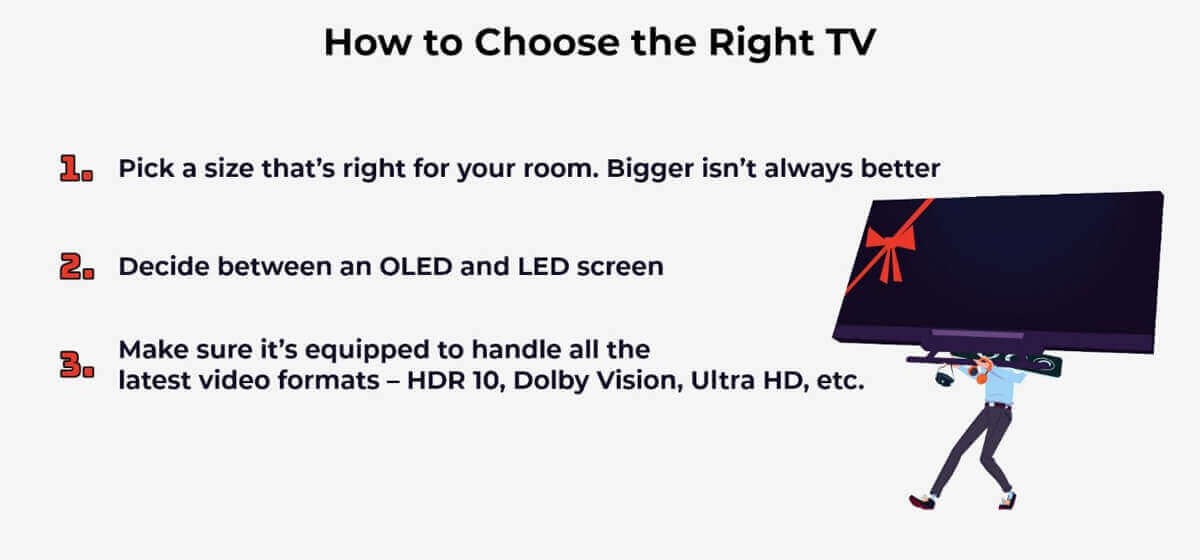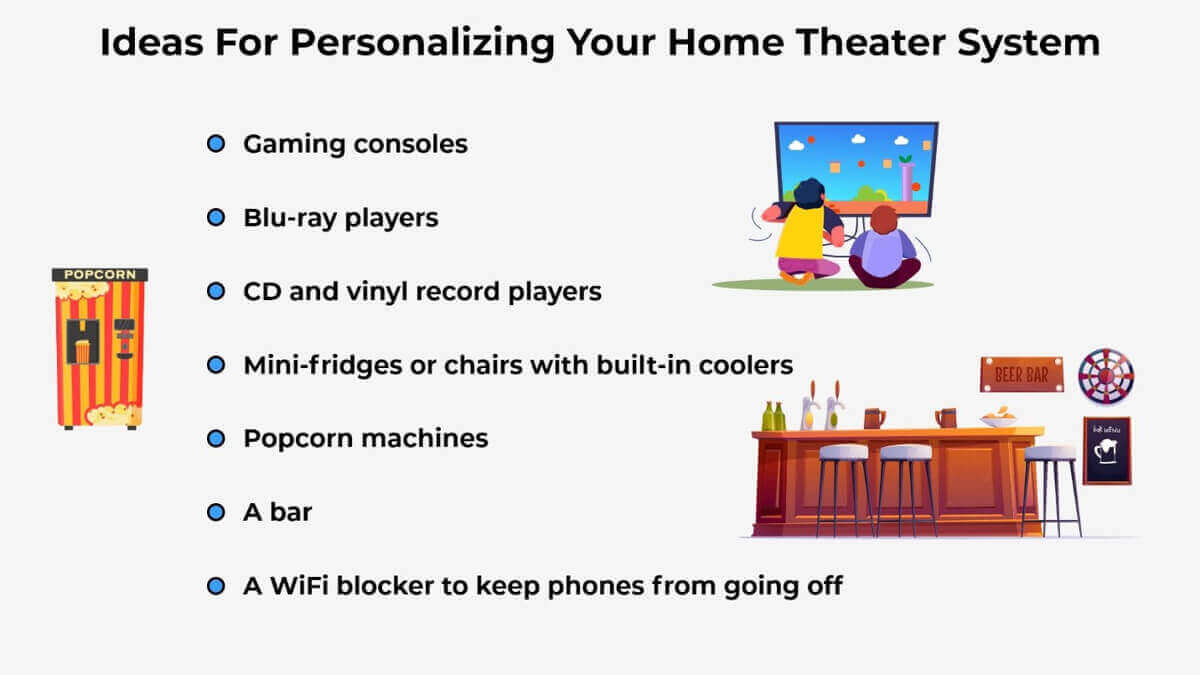How to Build the Ultimate Home Theater

Table of Contents
While the cinema is still the best place to experience a major motion picture, there are many reasons to avoid theaters. Aside from safety concerns about COVID-19, meaning many theaters are closed as we write this, there’s also the price of tickets and concessions. Taking a family of four out to a show can cost a small fortune, plus there’s the crowds, the noisy person behind you kicking your seat, and the endless advertisements and previews. Even after a great film, it’s not uncommon to walk out and say, “I wish I could have just stayed home."
But to stay home and also fully experience the movie you’re watching, you need to have the right setup. In fact, a properly designed home theater system can help you closely mimic what it would be like to go to the movies, and can even be much better considering you don’t need to leave your house. Additionally, home theaters are great places to watch games and listen to music too.
However, there’s both a science and an art to setting up a home theater system. It’s not enough to go out and buy a big TV and a surround sound system. You need to think about a lot of other factors so that the considerable amount of money you’re going to spend on all this equipment goes to good use and delivers the type of system that will provide the ultimate experience.

Start By Choosing a Room
Before we get into all the different devices and appliances you can and should buy to create a state-of-the-art home theater system, we need to talk about where in your home you’re going to put this setup. Again, this will be a significant investment, so it’s essential to start off on the right foot. Here are the main factors you need to consider:
Bigger or Smaller Rooms?
The first thing to consider is the size of the room you want to use for your home theater system. Large rooms can accommodate more people, a larger TV, and a bigger sound system, but all of this means you will need to spend money. And if you choose a big room but don’t invest in the equipment, your setup is going to suffer. A small TV will look silly and downgrade the viewing experience, and if you don’t have a powerful enough sound system, your audio will easily get drowned out.
On the other hand, a smaller room can be cozier and more intimate, but if it’s too small, you may not be able to get much of a sound system. You will be limited as to how large of a TV you can get, both of which can prevent you from setting up a real home entertainment system, leaving you with a regular old TV room instead.
Of course, which room you choose to use will depend on the space you have available, but we recommend trying to find somewhere that can comfortably seat six to eight people. This will give you enough options when it comes time to buy equipment and set it up.
Avoid Squares and Other Odd Shapes
Another thing to consider when choosing which room to use as the center of your home entertainment system is its shape. Perfectly square rooms are not ideal as they tend to mess with the way sound waves travel. It’s also not great to pick a room that has weird wall shapes – corners that jut out, inserts, etc. – as this can also make it difficult for sound to move around in the right way, and it can also make it challenging to find the right place to put the TV.
If you have a nice rectangular room you can use, keep in mind that it’s best to keep the TV in the middle of one of the longer walls. Obviously, all of this is once again dependent on the space you have available in your home, but these are the kinds of things that are important to keep in mind if you want to build a home theater system that deserves the title “ultimate."
Pay Attention to the Lighting
As you probably know, lighting is incredibly important to your home entertainment experience. The darker you can make the room, the better it’s probably going to be. Bright lights can mess up the colors on your TV and also produce a glare. As a result, try to choose a room that you can easily make as dark as possible. A finished basement room is ideal as these rooms rarely let in much light from the outside, but this isn’t possible for everyone.
If such a setup isn’t possible for you, then consider choosing a room that doesn’t have lots of windows, or that doesn’t face the street or some other source of outside light, and then use large/thick curtains which you can draw over the window to make the room darker.
Another thing to consider is the color in the room. If there are lots of reflective surfaces, or if the walls are painted a bright color paint, then the light from the TV will reflect around a lot, diminishing the quality of the picture on your screen and disrupting the overall viewing experience.
Hardwood versus Carpet
One more thing to consider is the type of flooring in the room you’re going to use. Carpets are infinitely better than tile or hardwood, both of which will cause the sound to bounce around like crazy, potentially creating an echo and messing up the quality of the audio coming from your system.
If you don’t have any rooms in your home that have carpet in them, you’ll want to invest in a quality area rug that can cover up the hard floor and produce a better sound experience.
Now Choose a Television

Once you’ve chosen the room you’re going to use for your home entertainment system; the next step is to decide which TV you want to install. This is important as this device will likely serve as the centerpiece of your entire setup, and likely to be one of the most expensive purchases, so make sure you take time to consider all of the following:
Size
When buying televisions, most people tend to think “bigger is always better." But this really isn’t true. Instead, the size of the television you get will depend mainly on the size of the room you plan to use as your home theater.
Larger TVs are meant to be viewed from further away and really should be mounted onto the middle section of a wall, not jammed into a corner. Putting an 85" TV into a small room will overwhelm the entire space and even make viewing uncomfortable – so much bright light that close is not good for the eyes. On the other hand, a TV that is too small for your room will make the picture seem even smaller and make it harder for the various viewers to enjoy the experience.
For most people, 55"-75" models will do just fine. Only in the rarest of circumstances does 85" really make sense. And, of course, we must also keep the price in mind. Televisions that measure more than 75" almost always cost more than $2,500, which is quite the price tag and is money you should consider not spending unless it’s genuinely going to enhance the experience.
Screen Type
The next thing you’ll want to decide is what type of screen you want your TV to have. The best of the best are OLED screens. OLED stands for Organic Light Emitting Diode. These TVs are made up of self-illuminating pixels that, when directed, can completely turn off, meaning they produce true blacks and have infinite contrast.
As a result, picture quality on OLED TVs is unmatched, even though they are much less bright than other screen types. LG is the leader in OLED technology, and they have several different models that can accommodate a few different budgets. Sony also makes OLED TVs that are very high quality, so also give them a look when shopping around.
The other major screen type is LED LCD, which stands for Light Emitting Diode Liquid Crystal Display. It’s a technology that’s been around for a long time, and its main benefit is that because it makes use of a backlight to illuminate the pixels on the screen, these TVs are very bright, which is another vital component of picture quality.
However, contrast tends to be not as good, and picture quality degrades considerably when the TV is viewed from an angle, which doesn’t happen with OLED screen. Their significant upside is that they are considerably cheaper than OLED screens while providing a picture quality that is still excellent.
If you do decide to go with an LED screen, we suggest looking for something with Quantum Dot technology, which was designed to help solve the problem that LED screens can’t ever produce true blacks because of the backlight. It’s quite effective and allows consumers access to OLED-type quality for much less cost. Samsung’s QLED models are excellent examples of this, as Vizio’s P Series Quantum TVs are considerably cheaper than most of the models discussed but still very high quality.
4K Ultra HD, Dolby Vision, Dolby Atmos, HDR 10+, HLG
If you haven’t bought a new TV in a while, you’re going to quickly find out that there are all new formats for video content. It’s important you know what they are so that the TV you buy is fully up-to-date and able to handle the changes coming to how we watch TV. Here’s a summary:
4K Ultra HD – This refers to the screens resolution (4,000 pixels). Top of the line TVs first had 720p, then 1080, and now 4K. If you want your home entertainment system to be the best of the best, it needs to be equipped with 4K Ultra HD. But this should be easy to find since any TV worth its salt these days will come with this capability.
- HDR 10 – HDR stands for High Dynamic Range, and it’s a way of processing images that allows for more data to be handled at once, leading to better, more accurate pictures. It started as plain old HDR but was soon upgraded to HDR 10, so keep an eye out for this when shopping. Again, any top of the line TV should come with this capability, and skipping out on it will cause your home theater system to suffer.
- HDR 10+ – Related to HDR 10 in that it’s the same basic idea – a way of processing images that leads to better pictures – HDR 10+ is Samsung’s proprietary technology and is therefore only found on their devices. There is a bit of a battle going on to see which format will win out, and while HDR 10+ started behind, deals with major studios to produce content in HDR 10+ format have changed things a bit. Unfortunately, because they are competitors, TVs will come ready to handle one or the other – HDR10 or HDR 10+. As of writing, we recommend sticking with HDR 10 as this is still the leader, but things may change. We recommend checking the latest trends before purchasing.
- Dolby Vision – Another video content type, Dolby Vision is often found in conjunction with other HDR formats, either HDR 10 or HDR10+, though slightly different from both. To truly be at the cutting edge, you should look for TVs that can handle this format.
- HLG – This is a version of HDR 10 that is used for live broadcasts. It’s still new, but it’s rapidly becoming the norm. If you plan to use your home entertainment system to watch live sports, make sure to find a TV with HLG compatibility.
As you can see, there are lots of things to consider. As for formats and picture quality, you can rest easy knowing that any of the top models from LG, Sony, Samsung, and Vizio will come equipped to handle most, if not all, of the video formats available. This means you can narrow your search to these companies and look for models that fit your size needs and budget.
Find the Right Speakers
Almost as important as the video system in your home theater is the audio. It’s often the booming sounds and dramatic music we hear in the theaters that make for such a high-quality experience.

The first thing to do when looking at speakers is to decide on an amplifier/receiver. This device is what’s going to deliver sound from your TV to the speakers connected to your system. The most important things to consider are:
- Power – Measured in Watts, this is an important factor as it will determine how loud your speakers can be. More power isn’t always better, though, and it’s important your speakers can handle what the amplifier is doing. As a general rule, 100W of power is going to be enough for most home theater systems.
- Impedance – Also known as resistance, this is measured in Ohms. In general, your amplifier/receiver and speakers will have either 4 Ohms or 8 Ohms of resistance. Still, the most important thing is that the resistance in your amplifier matches that in your speakers.
- Sensitivity – This refers to how much power your speakers need to get to higher volumes. More powerful amps require less sensitive speakers and vice versa.
If this is confusing, don’t worry. There are ways to make things simpler. One way is to buy all of your sound equipment from one manufacturer. Many top companies, such as Bose, Sony, LG, etc. sell complete surround sound kits – usually for around $2,000 – that are designed for one another, eliminating a lot of the guesswork.
Of course, customizing your system will make it better, but it’s not entirely necessary. Another option is to hire a sound technician to help you and do a lot of the background research for you. Again, audio is just as important as video, so if you want the ultimate home theater system, you need to treat it as such when you’re setting up your system.
Speaker Type and Placement
To make sure you’re getting the best possible sound experience, keep in mind the different types of speakers and where they should go.
Make Your Home Theater Smart
In the 21st century, any home theater deserving of the term “ultimate" must also be equipped with smart technology. Luckily, you won’t need to do too much extra work to make this happen as almost all of the devices available on the market, especially the higher-end ones, come with this capability.
One thing you should consider getting is smart lighting. These are bulbs that you can control with an app, meaning you can easily adjust the brightness and even color without getting out of your chair. This can be a really neat way to enhance the viewing experience.
However, to really harness all of this technology and make it more convenient, you’ll want to get a smart entertainment hub, which is a device that will connect all of the different things in your home theater so that you can control them from one spot.
We recommend the Logitech Harmony Hub as it comes with an excellent app and remote control that makes it very easy to use. That said, it’s limited in terms of how many devices you can connect – just eight. Another option for those looking to connect more devices is the Amazon Echo Show, which allows you to control the various smart devices in your home with your voice and an HD touch screen.
Properly Furnish Your Home Theater
With the room, TV, sound system, and a smart home hub all chosen, your home theater is pretty much all set. But to finish it off, you need to furnish it properly. For seating, the most important things to consider are placement – you want to make sure every seat has a direct view of the TV, or as close to it as possible, and also that it is in the middle of all the speakers – and viewing height.
If you buy really low chairs and put your TV high up on the wall, your experience will suffer. Home theater recliners are great options for those using a space that will be nothing more than your home theater, as they allow people to customize how they want to sit.
In general, this will be pretty intuitive, but we recommend trying out different angles and deciding what’s best before you go out shopping to ensure you don’t spend money on something that’s not going to work.
Once you’ve got your seating figured out, consider some other things, such as:

You could also consider putting in a dartboard, a pool table, a disco ball, a bar, etc. In fact, it’s these things that will genuinely make your home theater your own. Every system will have a TV, a sound system, and furniture, but the unique combination of gadgets and gizmos you add will make it unique and something of which you can be truly proud.
Conclusion
As you can see, there is a lot to consider when building a home theater system, and given how expensive these setups are, it’s crucial you take your time. Here we’ve outlined all of the key components of a system that can be considered one of the best, which we hope will provide you with guidance as you begin to plan your system and shop for equipment. However, if you are still unsure, we recommend getting professional design help. Yes, this will increase the expense, but it will also prevent you from making any costly mistakes that will prevent you from building the ultimate theater system right in your home.












 Call
Call 

 Access Your Account
Access Your Account